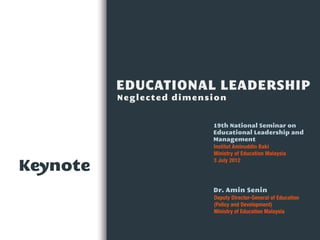Educational Leadership: Neglected dimension
- 1. EDUCATIONAL LEADERSHIP Neglected dimension 19th National Seminar on Educational Leadership and Management Institut Aminuddin Baki Ministry of Education Malaysia 3 July 2012 Keynote Dr. Amin Senin Deputy Director-General of Education (Policy and Development) Ministry of Education Malaysia
- 2. What dimension? Content of presentation Why neglected? How to restore? ║▌║▌▀Żs presentation by Dr. Amin Senin
- 3. Leading Managing What? LEADERSHIP Cultivating ║▌║▌▀Żs presentation by Dr. Amin Senin
- 4. Leading What? LEADERSHIP ŌĆ£By leadership, I mean influencing othersŌĆÖ actions in achieving desireable ends. Leaders are people who shape the goals, motivations, and actions of others. Frequently they initiate change to reach e x i s t i n g a n d n e w g o a l s . . .ŌĆØ ( Cuban, L., 1988 ) ║▌║▌▀Żs presentation by Dr. Amin Senin
- 5. Managing What? LEADERSHIP ŌĆ£Managing is maintaining efficiently and effectively current organizational arrangement. While managing well often exhibits leadership skills, the overall function is toward maintenance rather t h a n c h a n g e .ŌĆØ ║▌║▌▀Żs presentation by Dr. Amin Senin
- 6. What? LEADERSHIP Cultivating ŌĆ£. . . educational leadership is first and foremost about the work of educating. . . That is to s a y, e d u c a t i o n a l l e a d e r s h i p should be about developing e v e r y o n e ŌĆÖs u n i q u e h u m a n resources in order to fully e n a c t t h e e d u c a t i n g p r o c e s s .ŌĆØ ( Rober t J. St ar rat , 20 11) ║▌║▌▀Żs presentation by Dr. Amin Senin
- 7. What? LEADERSHIP Cultivating ŌĆ£. . . the term human resources to refer to those human resources each individual brings to the work of teaching and learningŌĆöthose talents, dispositions, interests, life experiences, cultural proficiencies, and prior education that comprise their p e r s o n h o o d , t h e i r h u m a n i t y.ŌĆØ ║▌║▌▀Żs presentation by Dr. Amin Senin
- 8. What? LEADERSHIP Cultivating ŌĆ£In short, educating is all about the human development of young people , and the attendant learning of their t e a c h e r s a s t h ey p ro b e w ay s for their pedagogy to activate the human resources of the y o u n g l e a r n e r s .ŌĆØ ║▌║▌▀Żs presentation by Dr. Amin Senin
- 9. Systemsworld Why? ŌĆ£colonizationŌĆØ Lifeworld ŌĆ£Colonization of the lifeworld. . . occurs when the systemsworld begins to dominate the lifeworld. . . colonization happens gradually and goes largely u n n o t i c e d .ŌĆØ ( Thomas Se rg iovanni, 2004 ) ║▌║▌▀Żs presentation by Dr. Amin Senin
- 10. Why? Lifeworld ŌĆ£ The lifeworld provides the foundations for the development of social, intellectual, and other forms of human capital that contribute, in turn, to the development of cultural capital that contribute, in turn, to the development of cultural c a p i t a l .ŌĆØ ║▌║▌▀Żs presentation by Dr. Amin Senin
- 11. Why? Systemsworld The systemsworld, by contrast, is a world of instrumentalities, of efficient means designed to achieved end. The systemsworld provides the foundation for the develoment of management and of organizational and financial capital that, in turn, contribute to the development of material c a p i t a l .ŌĆØ ║▌║▌▀Żs presentation by Dr. Amin Senin
- 12. Development of How? Professional Capital ║▌║▌▀Żs presentation by Dr. Amin Senin
- 13. How? Professional Capital H u m a n Social Decisional ( Fullan & Hargreave s , 20 12 ) ║▌║▌▀Żs presentation by Dr. Amin Senin
- 14. Professional Capital How? Human Capital ŌĆ£Human capital in teaching is a b o u t h av i n g a n d d eve l o p i n g the requisite knowledge and skills. . . It is about possessing the passion and the moral commitment to ser ve all children and to want to keep getting better in how you provide that ser vice . Human capital is about individual t a l e n t .ŌĆØ ║▌║▌▀Żs presentation by Dr. Amin Senin
- 15. Professional Capital How? Social Capital ŌĆ£Social capital refers to how the quantity and quality of interactions and social relationships among people affects their access to knowledge and information; their senses of expectation, obligation, and trust; and how far they are likely to adhere to the same norms or codes of b e h a v i o r.ŌĆØ ║▌║▌▀Żs presentation by Dr. Amin Senin
- 16. Professional Capital How? Decisional Capital ŌĆ£. . . is the capital that professionals acquire and accumulate through structured and unstructured experience , practice , and reflection - capital that enables them to make wise judgements in circumstances where there is no fixed rule or piece of incontrover tible evidence to g u i d e t h e m .ŌĆØ ║▌║▌▀Żs presentation by Dr. Amin Senin
- 17. thank you ║▌║▌▀Żs presentation by Dr. Amin Senin

















